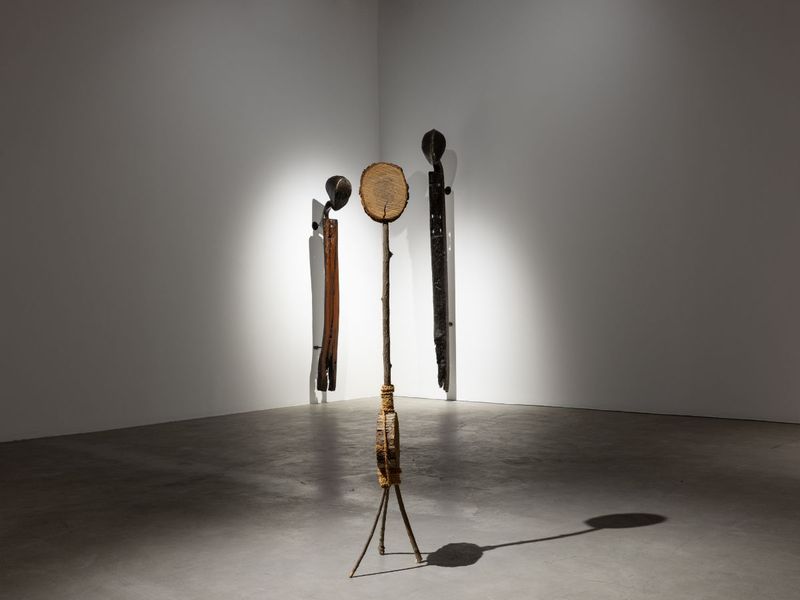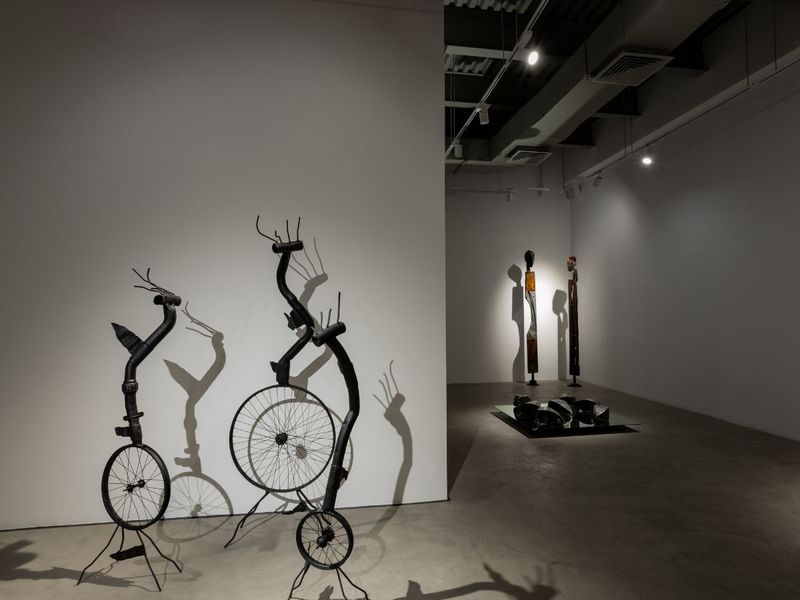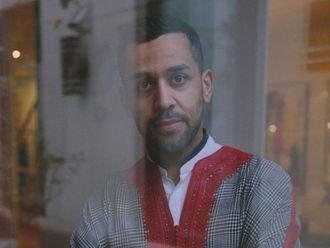
Inside Efie Gallery in Dubai’s industrial area of Al Quoz several whimsical, delicately made sculptures from natural materials seem almost akin to living beings. They embody a rhythmic sense of movement due to their curvaceous abstracted forms and materials such as old palm tree fronds, wood and steel. Works such as Camel Movement series (2005) by Emirati artist Dr. Mohamed Yousif comprising dried palm seed branches, jute rope, neem tree branches and almond tree branches that move ever so slightly in the air to seemingly emulate the movements of camels in the desert, are placed next to Still Whole (2024) by Kenyan sculptor Maggie Otieno, an abstracted head made from steel that graciously tilts its head to one side—sculptures that appear to have stopped momentarily in time. Both works retain the earthy hues of the material from which they were made offering viewers a sense of the earth, comfort, play and contemplation.
Titled Solace in Soil, the exhibition, which runs until October 6, is curated by Emirati Shamma Al Mheiri, and explores the practices of both artists and their engagement with their respective natural environments as way to examine the unique culture and identity of their birthplace.
Additionally, the evocative, earthy and largely minimalist works on show explore the connections between the Arabian Gulf and East Africa through art—connections that have rarely been examined through such a joint simultaneous showing of artists from both continents. Despite geographical and cultural differences, the works on show celebrate the commonalities that link both artists as well as their distinctive creative processes.

A strong element in the exhibition is movement and the experimentation of both motion and stillness through sculpture. In the main exhibition area Dr. Yousif’s 2005 installation titled Gazelles made from exhaust pipes, bicycle wheels and metal wires reflects a state of rhythmic movement like that of the Arabian gazelle which can often be spotted in the desert landscape of the United Arab Emirates. In the background, stationed at the end of space are Otieno’s tall elongated figurative forms— Unforgotten Memories I (2024) and The Sojourner (2021)—made from mild steel with railway sleepers.
Otieno, born in Nairobi, Kenya in 1974, has long focused her work on the creation of tall, elongated figures that are made from what she calls “distressed railway sleepers”—a particular railway sleeper wood over 150 years old that has traversed the forests of India to Kenya to create the ‘Iron Snake’ or Kenya and Uganda Railway line in 1896. Otieno, based in Nairobi, did not formally train as a sculptor and instead began her practice as a painting after joining Kuna Trust Art Center in 1996 where she was first introduced to sculpture by Kenyan sculptor Elijah Ogira. She fell in love with the medium and particularly with working with found objects with a special preference as can be witnessed through her works on display in working with wood and metal.
The wood of this railway carries with it, explains Otieno, the stories and experiences of hundreds of workers, travelers and diverse cultures.
The poignancy of her sculptures is thus not just found in their aesthetic form but also their materiality. Her long figures often have a solemn, contemplative look as if cocooned within themselves as if they are in silent conversation.
A strong commonality between both artist’s work is their reverence for their materials.
“I find the distressed wood beautiful,” says Otieno. “Someone might find when something is distressed that there is no beauty there, but I find the imperfections in the material, in the wood, make it more beauty. Its experience makes it more beautiful.”

The metal Otieno incorporates in her sculptural forms are similarly found after an in-depth research process of scavenging and investigating.
“I collect a lot of junk,” she says. “I go to a lot of junkyards scavenging for materials that people are either discarding or are just selling that I find through references. I believe that the places where discarded materials are containing a lot of stories to tell. For me as an artist, I feel that my role is to capture those stories.”
Dr. Yousif similarly researches his materials and selects them appropriately to try and evoke specific experiences, particularly those that can be had in the desert landscape.
“Everyone says I am an artist, but I am not an artist, I just want to be an artist,” says Dr. Yousif, noting how making art is such a crucial part of his life as eating, drinking and speaking. “How can I work with certain materials? How does the material evoke movement and the sound of the desert?”
Born in 1953 in Sharjah, Dr. Yousif is one of the first sculptors in the United Arab Emirates and credited as one of the founders of the Emirates Fine Art Society and the Sharjah National Theater. His is in the collection of the Sharjah Art Foundation and has been featured in numerous exhibitions, including in The National Pavilion of the UAE at the Venice Biennial in 2015 and 2017; Language of the Desert at the Kunstmuseum in Bonn, Germany in 2005), the Bangladesh Biennial where he won the First Golden Prize in 2004 and the 5th New Delhi Biennial, India in 1982.
Solace in Soil marks Efie Gallery’s first showing of an Emirati artist.
“There has been a big gap for the presentation of African artists in Dubai and in the UAE in general,” said Shamma Al Mheiri, noting how the arrival of Efie Gallery in 2021 began to fill this gap—especially through exhibitions such as this which work to forge cultural dialogue through art.
“There are a lot of commonalities between both artists in terms of materiality and the organic component of their craftmanship and their focus on their natural environment,” adds Al Mheiri.
“In terms of the curation of both artists, there’s so many elements that both Maggie and Dr. Mohamed share in common, from how each piece is crafted to the materials used which include very natural and manmade materials—also similar to each other for the colors incorporated all of which provides a real sense of grounding, and this is very special.”
In curating the exhibition, Al Mheiri says she looked at the individuality of each artwork and then how it would lend itself within a collective of artworks. This is the power and beauty of the works on show: encountering them is magical because they complement each other just as well as they do individuals and are further enhanced by the shadows, they make on the wall adding to the mystical experience of the exhibition.
“I wanted diversity coming into the gallery,” adds Al Mheiri. “I want people to look at the different types of artistic genres that are being practiced while underlining the theme of solace in soil, comfort with the earth, where we come from and where we will eventually go back to.”






